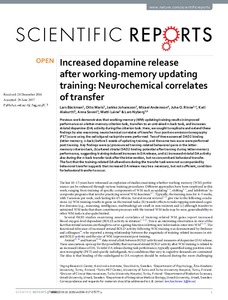Increased dopamine release after working-memory updating training: Neurochemical correlates of transfer
Lars Bäckman; Otto Waris; Jarkko Johansson; Micael Andersson; Juha O. Rinne; Kati Alakurtti; Anna Soveri; Matti Laine; Lars Nyberg
https://urn.fi/URN:NBN:fi-fe2021042717042
Tiivistelmä
Abstract
Previous work demonstrates that working-memory (WM) updating training results in improved performance on a letter-memory criterion task, transfers to an untrained n-back task, and increases striatal dopamine (DA) activity during the criterion task. Here, we sought to replicate and extend these findings by also examining neurochemical correlates of transfer. Four positron emission tomography (PET) scans using the radioligand raclopride were performed. Two of these assessed DAD2 binding (letter memory; n-back) before 5 weeks of updating training, and the same two scans were performed post training. Key findings were (a) pronounced training-related behavioral gains in the letter-memory criterion task, (b) altered striatal DAD2 binding potential after training during letter-memory performance, suggesting training-induced increases in DA release, and (c) increased striatal DA activity also during the n-back transfer task after the intervention, but no concomitant behavioral transfer. The fact that the training-related DA alterations during the transfer task were not accompanied by behavioral transfer suggests that increased DA release may be a necessary, but not sufficient, condition for behavioral transfer to occur.
Kokoelmat
- Rinnakkaistallenteet [27094]
